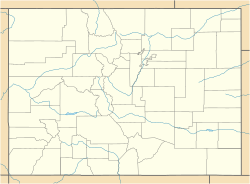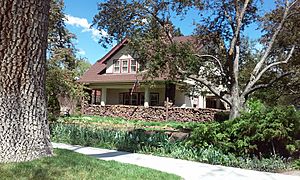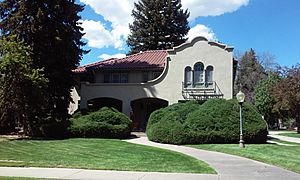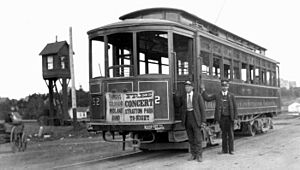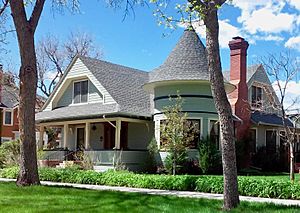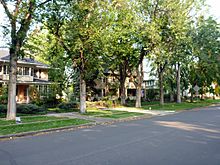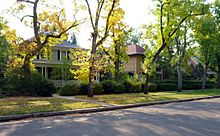Old North End Historic District (Colorado Springs, Colorado) facts for kids
The Old North End Historic District in Colorado Springs, Colorado is a special neighborhood. It's located north of Colorado College, between Monument Valley Park and Uintah and Lilac Streets. Until 2015, it was called the North End Historic District. The name changed when the area grew bigger.
This neighborhood was built for middle and upper-class families in the late 1800s. You can see many different house styles here, like Spanish Colonial Revival, Georgian Revival, and Mission styles. There are also newer styles like Modern Movement and Bungalow homes. Most of the houses were built between 1885 and 1965 and are still in great shape.
History Colorado, which helps protect historic places, says this district shows how Colorado Springs grew. It covers the time from the late 1800s gold rush to after World War II. Many homes were designed by famous architects of that time. The district was officially added to the National Register of Historic Places in 1982.
|
Old North Historic District
|
|
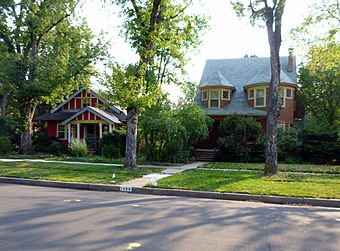 |
|
| Location | Neighborhood in the northern section of downtown Colorado Springs, Colorado |
|---|---|
| NRHP reference No. | 82001017 |
Quick facts for kids Significant dates |
|
| Added to NRHP | December 17, 1982 |
| Designated HD | 82001017 |
Contents
A Look Back at the Old North End
The very first building in the Old North End was a house for female students at Colorado College. It was built around 1881 by the college president, Edward Payson Tenney. This three-story Victorian house, called the Columbian Club, had a big porch and tall windows. Sadly, it burned down on January 1, 1884, when the students were away for Christmas.
In the 1880s, President Tenney also built the first house for the college president on Cascade Avenue. Colorado College bought land in what is now the Old North End as an investment. They called this area "New Massachusetts." But the city didn't grow very fast then, so the college lost money and sold the land. By 1888, the Old North End was mostly open grassland with just a few houses.
Growth from Gold Mining
Many homes were built in the neighborhood between 1890 and 1910. This was a time of big growth for Colorado Springs, thanks to the successful gold mines in Cripple Creek and Victor. The city became a center for mining businesses. The population of Colorado Springs actually doubled between 1890 and 1900!
Famous architects like Charles Thomas and Thomas MacLaren designed many of these homes. They built houses in styles like Tudor, Colonial Revival, and Queen Anne. People who lived here included gold stock brokers, mine managers, doctors, and judges. Some houses even had "sleeping porches" for people who came to Colorado Springs for its dry, mountain air to help with tuberculosis.
The 1200 and 1300 blocks of Wood Avenue were known as "Millionaires Row." Many of the neighborhood's wealthy residents, like mine owner James Ferguson Burns, had large mansions there.
Streetcars and College Connections
In the early 1900s, streetcars made it easy to get around the North End. The Colorado Springs and Interurban Railway ran electric trolleys on Tejon Street, North Weber, and Fontanero. These streetcars helped people travel until the 1930s.
The Old North End also has strong ties to Colorado College. The second president's house for the college is on the 1200 block of Wood Avenue. The Stewart House, another important building, was given to the college by Philip B. Stewart. Alice Bemis Taylor, a big supporter of the college, also lived on this block. Buildings like Taylor Dining Hall and Bemis Hall are named after her and her family. Charles L. Tutt Sr.'s house was also donated to the college and is now the Tutt Alumni House.
The neighborhood has stayed a great place to live throughout the 20th century. This is partly because of the continued growth of Colorado College, Penrose Hospital (which used to be Glockner Hospital), and businesses downtown. Many doctors, college professors, lawyers, and businesspeople have called the Old North End home.
During World War II, some garages, basements, and even whole houses were turned into apartments. These were used to house military members stationed at training facilities like Camp Carson and Peterson Field.
Medical Care in the Past
Tuberculosis Treatment
In the late 1800s, many people with tuberculosis came to Colorado Springs. They hoped the high altitude and dry air would help them get better. In the North End, there were places called convalescent homes and the Glockner Tuberculosis Sanatorium. Today, you can see a restored "tuberculosis hut" or "tent cottage" at Jackson Street and Cascade Avenue. It shows how people lived when they came to Colorado Springs for treatment.
Glockner Tuberculosis Sanatorium
Marie Gwynne Glockner opened the Glockner Tuberculosis Sanatorium in 1890. She built it to honor her husband, Dr. Albert Glockner, who had died from tuberculosis. In 1893, Glockner gave the sanatorium to the Sisters of Charity of Cincinnati, who were known for their excellent care. Over the years, it grew and became Penrose Hospital. The original Glockner Hospital building was taken down in 1959 to build the new Penrose Hospital.
Images for kids
- Highlighted houses in The Gazette [1], [2], [3], [4]


